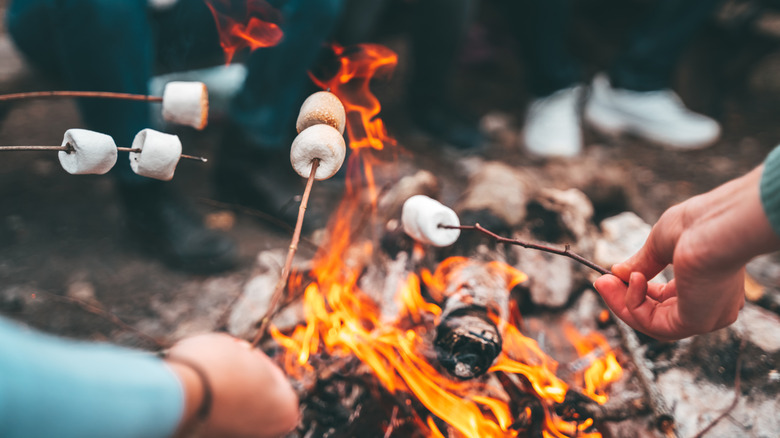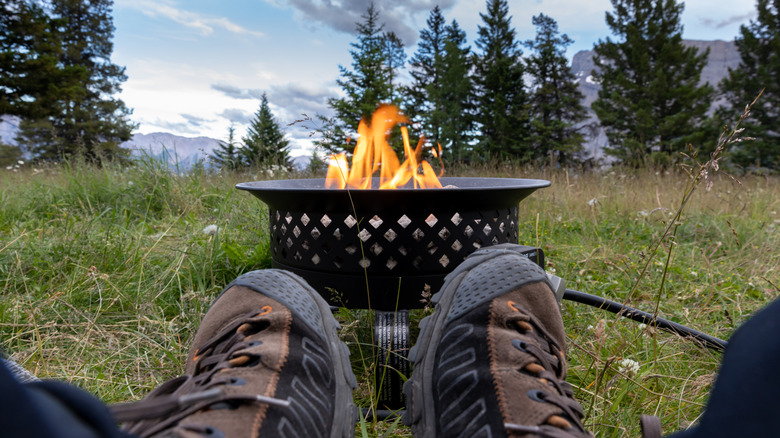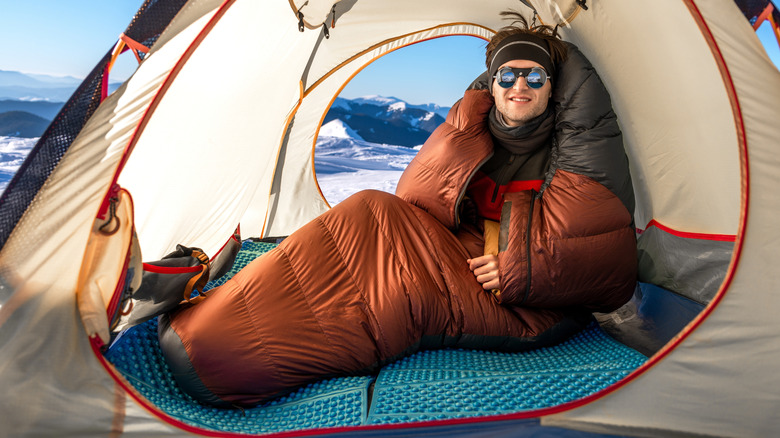Campfire Alternatives For A Safe Fire Season Camping Trip With S'mores And Sing-Alongs
Summer is just around the corner and that usuaully means it's time for a camping trip. Whether you're embracing solo camping as an antidote to loneliness or heading into the great outdoors with your friends and family, one thing's for sure: You'll certainly be looking forward to a night around the campfire. After all, horror stories, sing-alongs, and tasty s'mores are what camping is all about. Sadly though, many regions within the U.S. typically establish fire bans or restrictions during the summer months to prevent wildfires, which can be a turn-off for campers. Thankfully, not all is lost. There are many safer alternatives to fires out there that can allow you to still enjoy your camping trip to the fullest.
According to the National Park Sevice, 85% of wildfires in the country are sadly caused by humans. This means that fire bans and restrictions become crucial to protecting natural ecosystems. So, when a fire ban is in place within a given area or natural park, it means that not a single flame (not even a cigarette) should be lit. Certain alternatives to fires — such as stoves or grills — can also be listed under this ban. That's why it's always important to check directly with local park or environmental authorities before packing up for your trip.
However, once you've made sure which gadgets are still permitted during fire restrictions, you can then stock up on fire-safe campfire alternatives. Not sure where to start? Take a look at some of the options are listed below, all of which designed to help you prevent a fire as well as enjoy yourself while camping.
Cooking and heating up meals without a campfire
The first thing you're probably wondering is how you're going to enjoy a warm meal during your camping adventure if you cannot build a fire. Thankfully, there are plenty of good items out there for an easy camping retreat you can use. For instance, there are portable camping stoves, such as this Elite Gourmet Countertop Double Cast Iron Burner. Lightweight and compact, these stoves are perfect for cooking outdoors and they normally run on gas, which means you don't need to worry about finding electrical stations. This is especially important if you're visiting some of America's most remote wilderness areas, for example. Better yet, these kinds of stoves can also handle simmering, boiling, frying, and heating up meals rather well.
If, however, you're camping where electricity is available, you should consider investing in an electric portable stove. These stoves can really get the job done and further reduce the risk of a fire. Another great alternative (if allowed by your local authorities) are canister stoves. Although a little bit smaller than portable gas stoves, they're just as convenient.
Lastly, portable grills— which can either be gas or charcoal-fueled, like this Cuisinart Chef's Style Tabletop Portable Propane Gas Grill — are another great option to consider whenever they are allowed. Regardless of your choice, though, remember not to leave any cooking gear unattended.
Gas fire pits and LED torches can help recreate the atmosphere
Portable stoves are great when it comes to cooking, but let's be honest: Camping is all about sitting by the fire. That's why a great alternative to campfires is a portable gas fire pit. Fueled with propane gas and controlled with a switch, these fire pits typically pose less of a threat than your traditional fire. Plus, they're also amazing for roasting some s'mores and other treats (but only if allowed by local authorities).
Similarly, portable camping fireplaces also exist and are great for cooking, roasting marshmallows, or just spending a nice evening by the fire. These fireplaces can be fueled by either gas, wood, or charcoal, and they're a solid option for wet and humid places. Better yet, they're also safer than a campfire.
If you're more worried about the vibes, there's the option to bring along an LED fire. These types of "fake fires" are a great option for protecting the environment, and they'll add a nice touch to your camping setup. If that sounds like too much hassle, glow sticks are another fun alternative that you can use to light up your campsite. And, while you're at it, you can also use them to play around and even practice some creative photography. Finally, another great option is to simply to embrace the dark and completely ditch the fire and lights — especially if you're planning to visit some of the best national parks in America for stargazing.
How to stay warm and toasty without a campfire
We've looked at a few different ways to cook without a campfire, but what about ways for staying warm? Don't worry, there are also alternatives for that. For instance, you could indulge in high-calorie foods and treats to keep your body temperature up. Alternatively, you could bring a space heater with you on your trip — like this handy portable outdoor patio heater, available on Amazon. There are many great small, safe heaters in the market that are actually perfect for camping. Best of all, some of them don't even require an electrical hookup, as there are propane-fueled options available.
Finally, the smartest thing to do for staying warm is to always pack the right camping gear. For starters, one of the most important items you'll need for a camping trip is a warm and comfortable sleeping bag. Even better if you pair it with insulated sleeping pads. Additionally, waterproof jackets are another must, as is the right layering of clothes and socks. In terms of where you'll want to sleep, weather-sealed tents with windbreakers and insulation can come in handy as well.
If all else fails, you can always rent an RV and look into the different budget-friendly ways to ensure it stays warm. Plus, having one also means you'll get to make use of their built-in cooking stoves, most of which are either electrical or fueled by gas.



